With a laptop and a good Internet connection, you can work from almost anywhere. The world can be your office.
But, if you want to get the most out of working from home, a well-constructed workspace is essential.
In this simple and clear guide, we’re going to walk you through a few must-have home office essentials that promote productivity, creativity, and personal well-being.
And we’ll start with one most people don’t talk about.
1. The Best Environment for Your Personality
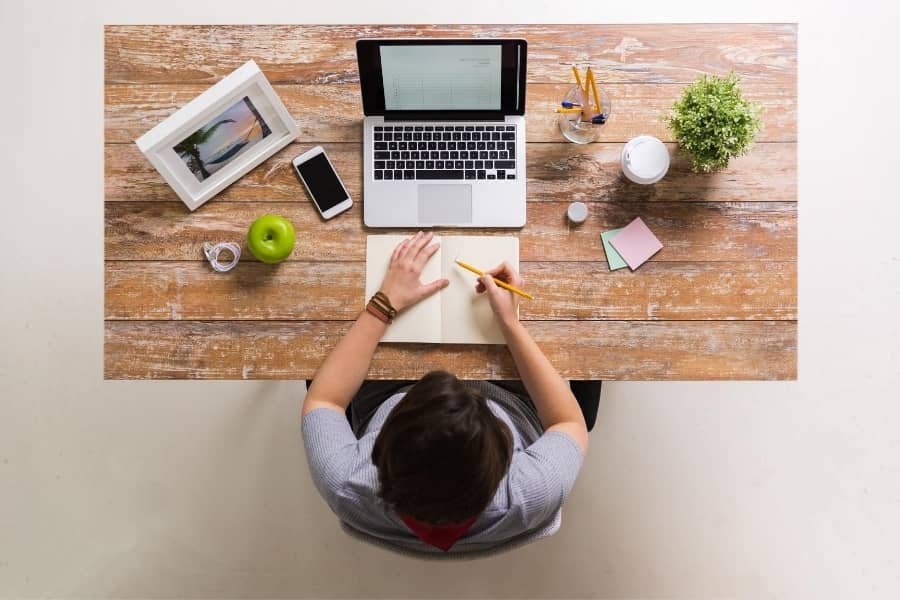
Matching your workspace to your personality can have a huge impact.
Here’s why:
Introverts Need a Sanctuary Space, Extroverts Need a Stimulating Environment
Introverts need a place to disconnect and recharge. To get into your flow, it should be a private, quiet room away from the hubbub of household activities.
If you don’t have a room of your own, create privacy by using a folding screen, hanging panel, a tall bookcase, or even a large plant. You can also meet your need for a separate space by fitting a closet with a work surface and shelving.
The second thing you need if you’re an introvert is a room where you won’t get distracted by a lot of visual stimuli. You’ll function much better in a restrained, carefully curated, and more minimal space.
For you, less is best.
The opposite is true for extroverts.
While introverts are bothered by noise and action, extroverts thrive on them. In fact, if you’re an extrovert, you’ll be much happier and more motivated with activity in the background.
This means that, if need be, you can integrate your workspace into an open, high-traffic area (just make sure you can have long, uninterrupted work periods to get “into the zone.”)
Extroverts perform best in a rich, sensory environment with a lot of texture, objects, scents, and sounds. For you, the best home office will be a lively and colorful space.
2. Clear Space for Clear Thinking
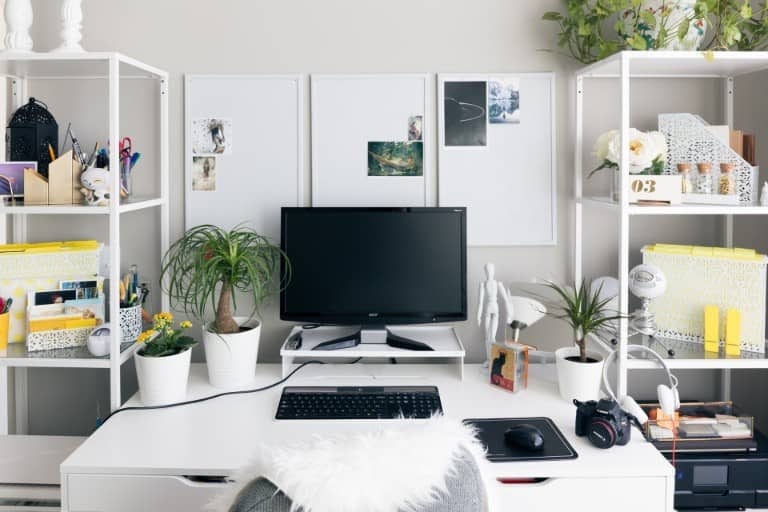
Maybe you don’t mind a room filled with papers, boxes, and piles of clothes.
But your subconscious does — Princeton University researchers found that it goes into major overdrive when you’re surrounded by clutter.
The result: You get depressed, slow yourself down, and get stressed.
As a remote worker, you know many things are out of your control. But what you do have control over is your workspace.
So, declutter your home office:
- Relocate everything that should be in other rooms;
- Get rid of anything you don’t really like or need;
- Keep a recycling bin next to your desk so it’s easy to toss papers;
- Decide what office supplies you need to have on hand, then hide the rest.
To the latter, here are a few tips:
- Store office products like staplers, notepads, file folders, and business cards in small, clear boxes and stack them out of sight.
- Office equipment like a paper shredder, laser printer, fax machine, and file cabinet can go into a closet since they’re not used daily.
- Put your walls to work with a whiteboard. Use it to hang papers that need immediate attention, sticky notes with article ideas, and inspirational clippings.
Finally, when organizing supplies on shelving and bookcases, keep in mind that:
- Introverts prefer storage to be outside their field of vision;
- Extroverts like to display containers in vivid colors to make their space feel more lively.

Now that you have a clear office space to work in, let’s discuss office furniture…
3. A Good Home Office Desk & Chair
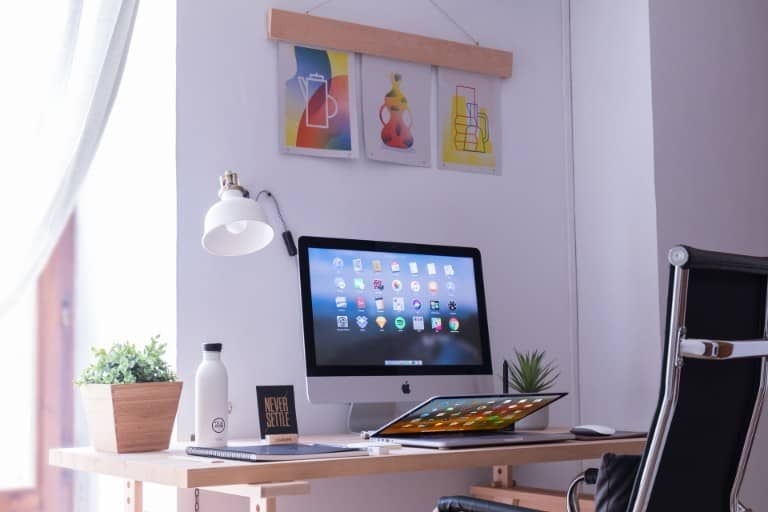
If your job requires you to spend hours each day sitting in front of a computer, a comfortable chair and proper desk are non-negotiables.
The desk is pretty straightforward — a repurposed dining room table with rolling files underneath or a work surface laid on top of two bookcases or file cabinets are two budget solutions that give you plenty of room to spread out.
Of course, there are more expensive options too. Whatever desk you choose, just make sure it’s sturdy and doesn’t wobble when you type.
For your chair, don’t repurpose a dining room chair or use something just because it looks Instagram pretty. You need a comfortable chair with adjustable height, arms, and lumbar support, or you’ll pay the price later with back problems.
Go for an ergonomic chair designed to support your back and hips and maintain good posture. The seat of a well-designed office chair should move up or down to allow you to sit with your feet flat on the floor so that your legs form a right angle to your back.
In my opinion, your desk chair should be the most expensive piece of office furniture you own. Check out Wirecutter’s Best Office Chair guide. No need to max out your credit card, though — you can find one at a fraction of the price at a used office furniture warehouse.
Where to Position Your Desk
When setting up your new office, place your desk first. Don’t automatically put it against a wall.
Ideally, the best desk positions are either with your back to a wall and facing the door, or perpendicular to a window.
Studies have shown when your back is to the door, there’s the primal sense that someone is looking over your shoulder — your subconscious becomes hyper-vigilant.
How to Practice Good Ergonomics
Even the most expensive ergonomic chair won’t prevent future problems if the rest of your desk setup is lacking. Make sure you also do these things:
- Position your keyboard (preferably an ergonomic keyboard) so that your forearms are parallel to the desk surface;
- Your eyes should look slightly down from the top of your desktop computer screen;
- Your feet should rest on either the floor or a footstool, with your knees at a 90-degree angle;
- Make sure your fingers and palms rest on the keyboard or mouse;
- Your elbows also need to be at a 90-degree angle while typing and using your mouse. Use wrist pads under your keyboard;
- Try to limit your laptop usage. While it’s fine to work on a laptop every once in a while, it’s a terrible position for your back and shoulders.

4. Essential Lighting
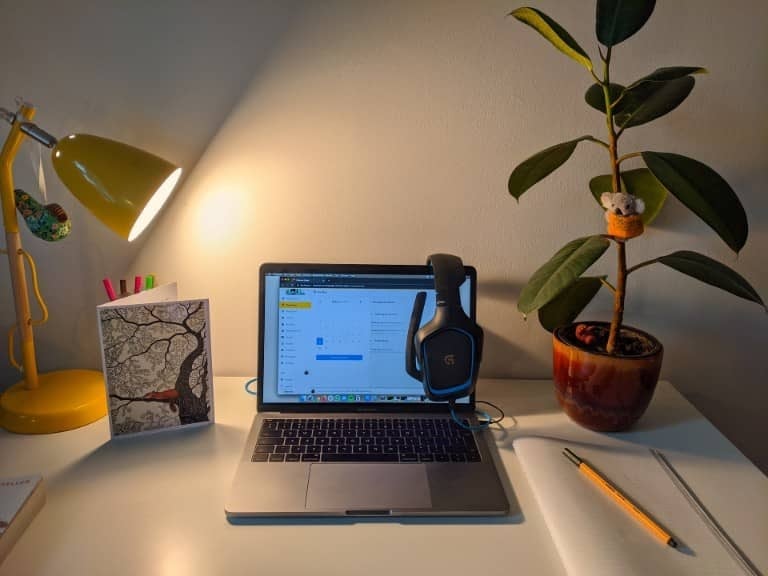
Adding more light to your workspace is one of the easiest ways to boost your energy and cut down eye strain.
Typical overhead lighting is inadequate for work. You also need a desk lamp that doesn’t cast glare onto your screen. It helps to prevent headaches, and reduces eye fatigue.
If at all possible, try to get as much natural light into the room as possible. Your health, well-being, and creative productivity are all affected by the life-giving rays of sunlight — or the lack of them. The amount of sunlight you receive and your mood are directly correlated because bright light exposure raises serotonin.
To replicate sunlight in your ceiling fixtures and lamps, use full-spectrum LED bulbs. They create clear, energy-efficient light without glare, which is especially important when you stare at a computer screen all day.
In addition, I highly recommend putting an adjustable light therapy lamp on your desk to keep your serotonin happiness hormone high.
5. Colors For Motivation, Focus, and Creativity
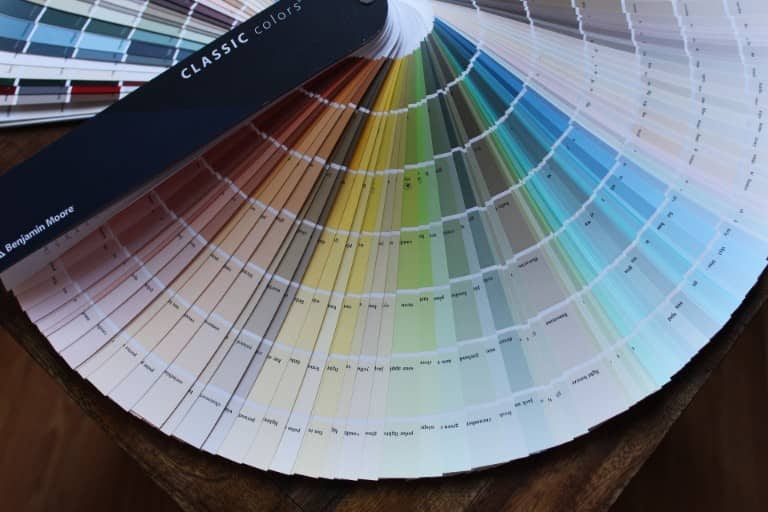
Bringing color into your office is one of the quickest ways to alter your mindset.
Color experts recommend using color to encourage productivity, creativity, focus, and communication. Whether it’s as the defining element in the room or as a recurring accent, color will inspire you to do your best work.
Regardless whether you look at color from room decor, desk accessories, or office supplies, or even clothing, you’ll get the same color psychology benefits.
Here are a few tips:
Blue is the best overall paint color for an office:
- It helps you concentrate if you’re having a hard time sitting still and finishing a project;
- It’s a calming color that helps reduce stress;
- People are more creative and productive in blue rooms;
- It encourages imagination and intuitive thinking.
Turquoise is a color to use when you’re stuck in a rut and don’t know which way to move. It also enhances concentration and creativity.
The color green boosts creative output more than any other color. Add it to the room with storage containers, decorative items, houseplants, or paint the walls sage green.
Yellow stimulates your mind and helps you focus. It’s the number one color for enhancing concentration. Look at something yellow when in a funk to improve your mood and restore a sense of optimism.
Energizing orange will help you to reduce self-consciousness and express yourself with confidence. It encourages social interaction. Orange is a good color to look at when you need to do a Facebook Live or Zoom presentation.
Red is another great color to use in a home office. It helps you stay motivated during the day. It raises blood pressure and increases heartbeat. But only use it in small amounts or it might make you agitated and short-tempered.
These Colors Are Not Recommended For Creative Spaces
There are two colors that have been found to deplete people’s energy, so it’s best not to use them as the predominant color scheme in the room where you’re doing creative work.
Gray makes some people feel drained and depressed. Also, if you’re playing it safe with gray, it indicates a lack of confidence and fear of exposure.
We associate brown with practicality and stability. It’s not a good overall color for a creative space because it tends to thwart spontaneity and the free-flow of ideas.
Colors for Introverts and Extroverts
Introverts feel most comfortable with cozy warm whites, muted greens, and blues. Add bright, glowing colors in your artwork to create a happy, feel-good space.
Extroverts will thrive with stimulating red, yellow, and orange in their decor.
6. Houseplants and Views of Nature
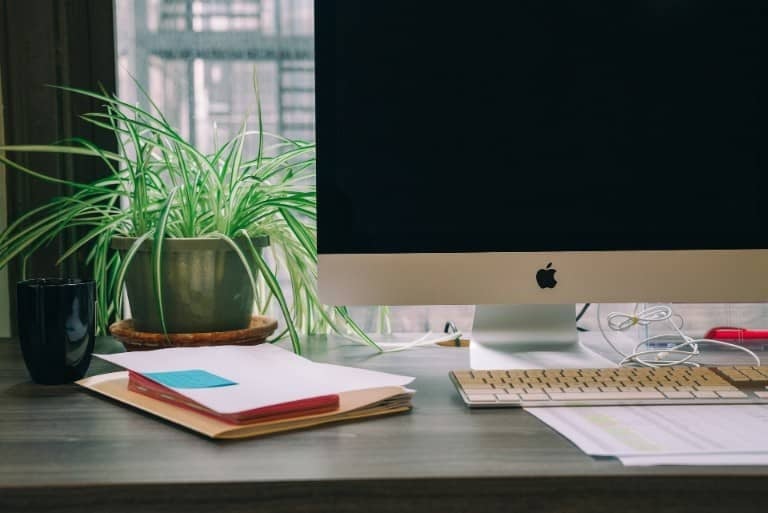
Besides aesthetics, there are many reasons to have houseplants in your home office. Put a plant on your desk and a few in the room. The bit of oxygen they provide will make you more alert.
Spark your creativity by adding a few plants to liven up the space. The general consensus is that it’s not necessary to make your office into a jungle. All you need is one to four houseplants to get all the benefits.
Viewing nature helps you to feel calm, refreshed, and opens your mind creatively. Studies show that looking out the window at trees and plants puts people in a more positive mood by giving our overactive minds a respite. Connect with nature when you need to take a break from your screen.
If you don’t have a nice view, photos of sweeping vistas, forests, and fields of flowers, or a mirror reflecting a window behind you, will do the trick.
7. Ambient Noise and Music
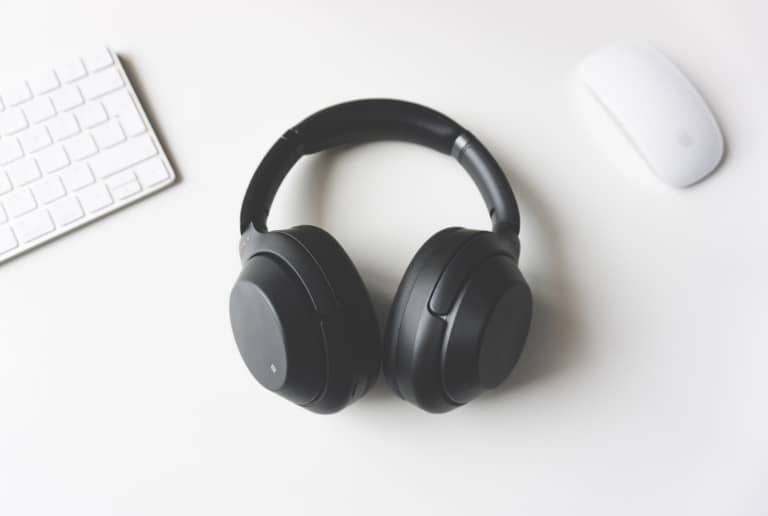
Both music and ambient noise help people focus and concentrate. Architect Donald Rattner says they make you more creative too.
Too much noise has the opposite effect though. If you struggle to find enough quiet to focus, mask distracting sounds with noise-canceling headsets.
If you find total silence unbearable, try a white noise machine that plays nature sounds like gentle rain, rolling thunder, bird songs, flowing streams and crashing waves.
Researchers have found that when you listen to music, stick with instrumental or choose songs you’ve heard a thousand times before because your brain uses up precious mental energy trying to figure out the words. Lyrics should be hardly noticeable and fade into the background.
Baroque Classical and ambient electronic music both fit the bill for helping to improve concentration without being too obtrusive.
8. Air That Inspires
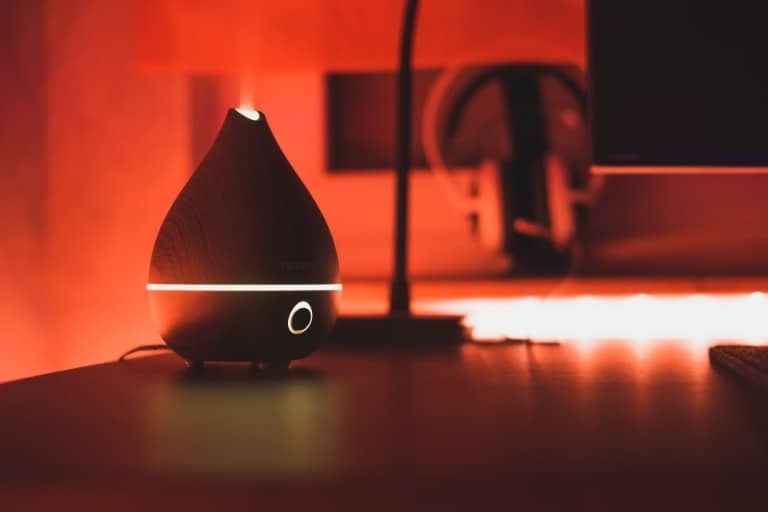
We often take it for granted, but the air we breathe has a strong impact on our productivity.
Here are a few ways to maximize the quality of the air in your home office:
Aromatherapy
It’s reported that William Shakespeare and Charles Baudelaire used essential oils to help them create their works. Rumor has it Leonardo da Vinci particularly liked neroli.
If you’re new to aromatherapy, herbalist Valerie Ann Worwood recommends the following oils:
- For better communication:
- carnation, geranium, grapefruit, peppermint, lemon
- For direction:
- cypress, rosemary, peppermint, cinnamon, grapefruit
- For imagination:
- coriander, ginger, orange, jasmine, carnation
- For inspiration:
- frankincense, neroli, bergamot, lemon, jasmine
- For originality:
- cardamom, tuberose, hyacinth, clove
Fresh Air
Polluted air fogs your brain and wears down your health and spirit. The quality of the air you breathe affects you on every level.
Open your windows to create some cross-ventilation to blow stale air out. Fresh, clean air is not only health-giving but also uplifting and inspirational. If you can’t open your windows, get a HEPA air purifier to filter out mold, dust, and toxins.
Let in the fresh air and boost your creativity.
Temperature
Warmth is a prerequisite when you need to spend hours working on a project. You simply can’t concentrate if the room is too cold.
Set your thermostat to 71 degrees. Studies have found that it’s the best temperature for peak productivity.
A Comfortable Workspace With Office Essentials Isn’t a Luxury
Whether you’re a writer, you own an e-commerce website, or you’re a programmer for a small business; having a dedicated, comfortable workspace that has the basic essentials isn’t a luxury — it’s vital to your success.
That’s why it makes sense to invest in the space where you accomplish your biggest goals and deliver your finest work.
So which office essentials are you going to implement in your own workspace?
Let us know in a comment below.




Hey Sara,
Thank you for sharing your insights with our readers!
Of everything you discussed, what do you think is the most important (the most essential “essential”) when setting up a home office?
I think the most important thing you can do for your health and productivity is to buy the best ergonomic chair you can afford. These days you’ll rarely find one that doesn’t claim to be ergonomic, so it’s important to look past the marketing and rather at how it’s built. Find a chair that can be adjusted to your body size and shape — basically, the more adjustability, the better.
A surprising amount of damage is done to your body if you hold parts of it in strange positions for hours at a time, five days a week. No matter where you’re WFH there’s a certain posture that will help reduce your risk of developing pain. Start by making your work surface elbow height and putting a solid object under your feet.
I’m curious…if you’re sitting in a gaming chair all day, what has your experience been?
Hey Sara,
I actually have a sit-stand desk that includes a treadmill. So, my part of my day I’m sitting (either in a standard computer chair or on a giant yoga ball), part of my day I’m standing (on top of an anti-fatigue mat), and part of my day (too small of a part, if I’m being honest) I’m walking on the treadmill.
I guess you could say I don’t have a typical setup. 🙂
Great post! I’ll use these tips to set up and optimize my home office.
Thanks, John. I’m glad you liked it.
Every element that goes into our home office not only determines how we use the space, but influences how we feel emotionally and physically — our mindset, and the state of our health and well-being.
Very inspiring! And very practical! Great combination, these two qualities. It seems every aspect of the home office was covered! Now I’ll have to apply these principles to my space to enhance productivity and creativity. Thank you for the suggestions to make this possible!
Thanks, Marsha. Please keep me posted on the changes you make. I’d love to hear about them!
Love this post! Working from home is so difficult sometimes. You’ve shared some great home office tips for keeping productive which I will be implementing for sure!
I’m so happy Liz that you love my post. Yes, working at home can be so difficult. I guarantee you that the time, energy, and care you put into your office will more than repay you with a space that makes you feel healthier, happier, and more productive.
Hi Sara,
thanks for this great post that will help me to set up my business office site now. thanks for this guide Sara
I’m very happy to help Maclean. Have fun setting up your space!
Wow! It’s an amazing post for creating a healthy workspace. I especially liked the part of having-useful-colors-at-display and keeping a natural plant on your desk. I think now is the time to have some greenery at my home office. I pretty much have the rest, excluding a few things like an air purifier.
Good read! Thanks for sharing.
Thank you, Sadaf.
Sounds like you have a great office!
You’ll be amazed at the power of color psychology. Adding a pop of green and other useful colors with your office supplies, shelf accessories, colorful books, and artwork will increase your energy, your mood, and your initiative.
I love the idea of plants on your desk. Having living plants in your home office will make your days more pleasant, and make you feel more energetic—not to mention, they make every space look better!
Hi Sara, just wanted to let you know that I had first opened this article in a place where I couldn’t read through it, but after a couple of paragraphs I emailed it to myself because I could see this would be a really useful piece. Now that I’ve had the chance to go to the end, all I can say is wow! You are an incredibly resourceful writer, each sentence chock filled with useful info. And I appreciate all the outside links to back up your material. Great job!
Thank you, Donald. As one of your biggest fans, I feel so honored! Your book, “My Creative Space” is one of my all-time favorites. I love how, with wry wit, you distill mountains of science-backed research and environmental psychology into simple things we can do in our home and workspace to change everything from our thinking to our physiology. I’m thrilled that you said, “wow” and find my article chock full of useful info!
This is a really great article. I especially like the sections on color and clutter. I really learned a lot about my own space!
Thanks, Tom. Color psychology is fascinating. For instance, some colors make you feel lazy and unmotivated, so I wouldn’t paint my office dark blue or gray. These colors are beautiful and cozy but probably won’t promote productivity and energy. And some colors are linked to imagination, so if you’re a freelance writer, a small amount of purple will help your imagination to soar. Then there’s the bane of everyone’s existence—clutter! It’s life-changing once you get a handle on it in.
Great post, Sara! The interesting subject was thoroughly analyzed and supported with excellent sources and helpful videos. I found the material on the uses of color and scent to be fascinating and especially intriguing. While I’ve always been able to find inspiration and creative insights nearly anywhere, my home office is my personal sanctuary for mental tasks requiring focus and concentration. As early as the late 1980s, I began to depend upon the use of earplugs and an uncluttered desk in order to read and study most effectively. I also wholeheartedly agree with the benefits of a high-quality ergonomic chair. It seems to me that options for lighting have dramatically improved over the past ten years or so. While relatively inexpensive, I really like the LED reading light I purchased last year (TaoTronics TT-DL046 floor lamp) and appreciate its versatility in color and brightness settings. Thank you for such a tremendously helpful post with many practical recommendations!
Wonderful! Thank you, Ryan. I’m so happy that I could offer more ways to make your workspace an inspirational sanctuary and a place where you can really focus and concentrate. We speak the same language—noise reduction, uncluttered desk, ergonomic chair, and great lighting!
Wow this are really Cool and Great tips, plus the great combination it really helps me a lot especially that I am looking for a guide to start our e-web business these tips and advice from you did really help me a lot. Thank you for sharing this Sarah hope you will make some more on other things to soon. And more people that you will be able to help.
Thank you so much Bryce. I wish you great success in your new business!
Hi Sara,
The list is wonderful.
Although every item on the list is quite essential to work peacefully for home, still I will go for a good office desk and a chair which I require immediately, some lighting I will arrange for my room and I am planning it for many days but it is not happening but definitely, I will do it now and a small hose plant for my working table.
I love to work in a cozy and clean environment which I am not getting for many days, but I will do this for myself.
Thanks
Dipanjan Biswas